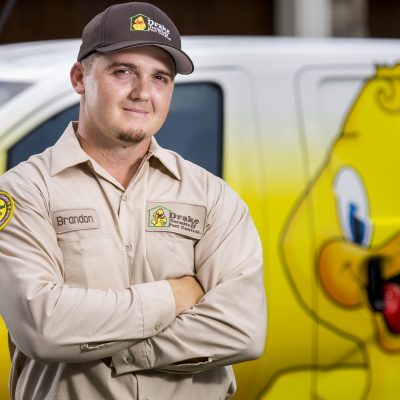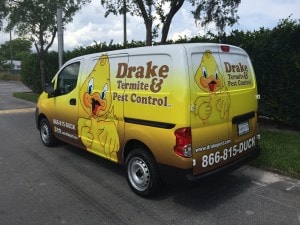Termites are a serious pest that can cause extensive damage to homes and structures. While they’re not usually dangerous to humans, an active termite infestation left untreated can slowly eat away at the structural integrity of a home.
Termites are also experts at finding hidden entry points and can go unnoticed as they tunnel through wood framing, flooring, trim, or other cellulose-containing materials. By the time the signs of an active infestation are visible, and you decide to call in pest control for termite infestations, the damage may already be quite extensive. That is why it is important for homeowners to understand how to identify termites and the early signs of an infestation.
Identifying Termites
Signs of Termites
As pest experts who deal with termites frequently, we know it’s important to catch them early before they do too much damage. So we want homeowners like you to be aware of some of the more common signs that might mean those termites are active near your home.
Mud Tubes: Mud tubes are a clear sign of subterranean termites, as these insects will construct thin shelter tubes made of mud to protect themselves as they forage above ground. Our technicians inspect for the presence of mud tubes contacting wood structures like the side of a home’s foundation.
Swarmers: The emergence of winged reproductive termites, also known as alates, from infested wood members is another tell-tale sign. Their swarming activity or shed wings found near windows or siding show that an active colony is present.
Damaged Wood: Initially, termite damage is often concealed within wood. As it progresses, you may notice bulges, cracking, hollow sounds or piles of wood shavings.
Indoor Signs: Look for mud tubes on the interior contacting wood or hollowed-out areas in wood. You may also find termite fecal pellets resembling coarse black pepper.
Types of Termites
Being able to distinguish between termite species allows for proper treatment measures to be implemented. The three main types encountered in Florida include:
Subterranean Termites: As their name suggests, these termites require constant contact with soil to survive. They construct mud tubes to forage above ground and shelter underground, and the workers are pale with indistinct wing markings if any.
Drywood Termites: Unlike subterranean termites, drywood termites do not depend on soil contact and can complete their lifecycle contained entirely within infested wood. They are small, ranging from pale yellow to white in coloration. Wings exhibit a uniform dark venation pattern.
Dampwood Termites: Occasionally, dampwood termites may also be encountered. As the name implies, they thrive in wood with high moisture content where mold growth is possible.
Preventing Infestations
Here at Drake Pest, we believe the best defense is a good offense. By building termite prevention into both new construction and existing homes, you significantly reduce the chances of these pests establishing themselves in the first place.
Moisture Control and Proper Firewood Storage: Termites need moisture to survive. Fix leaky plumbing and rain gutters, and ensure the soil grade slopes away from the foundation. Do not stack firewood against the side of the house, as this maintains moisture and provides a food source near vulnerable wood. Elevate stored firewood off the ground instead.
Foundation Vent Screens and Termite Shields: Subterranean termites can enter through unprotected openings. Foundation vents should be covered with metal mesh no larger than 1/16th inch to block entry. Termite shields made of galvanized metal or plastic are also installed during construction to create a non-continuous barrier around pipes, wiring or other penetrations.
Annual Professional Inspections: Regular inspections by a certified pest control professional are key, as signs of an infestation are not always visible to the untrained eye. Annual checkups help catch any issues early.
Sound Construction Practices: Proper grading and drainage, concrete footers extending below the frost line, and moisture barriers between foundation and wood framing make a structure less appealing to termites. Avoid wood contacting soil whenever possible.
Treating Infestations
At Drake Pest, our goal is to provide our clients with comprehensive termite treatment solutions. Our trained technicians have extensive knowledge of the latest EPA-approved methods to handle any active infestation.
For less severe situations, we may start with an integrated pest management approach as part of an overall treatment strategy. This may include non-chemical options like monitoring, trapping or localized heat applications.
However, for more severe infestations that have already started to impact your home’s structural integrity, chemical treatment is often necessary. Our soil termiticide barriers are installed using precision GPS and mapping technology to create continuous underground barriers around the entire foundation. Liquid and foam applications are also carefully employed to penetrate vulnerable areas.
In complex cases involving widespread damage, fumigation may be the most effective response. This technique utilizes tarp containment and gas dispersal to penetrate deep within voids and cavities throughout the structure.
Entrust Your Termite Pest Control to Drake Pest
Prevention is the name of the game when it comes to termites, and we’re here to help guide you with exclusion practices and professional treatments to keep these pests at bay. By working closely with our qualified pest management professionals, you can establish robust termite prevention, control, and monitoring plans customized to your property. Call us today to see how we can help you with your termite infestation!
Brandon is the President of Drake Lawn and Pest Control in Orlando, FL . He has over 30 years experience in the Orlando Pest Control Industry. He attributes his achievements to living by these rules: continuous training and education, providing honest work and striving for the pursuit of perfect service.


